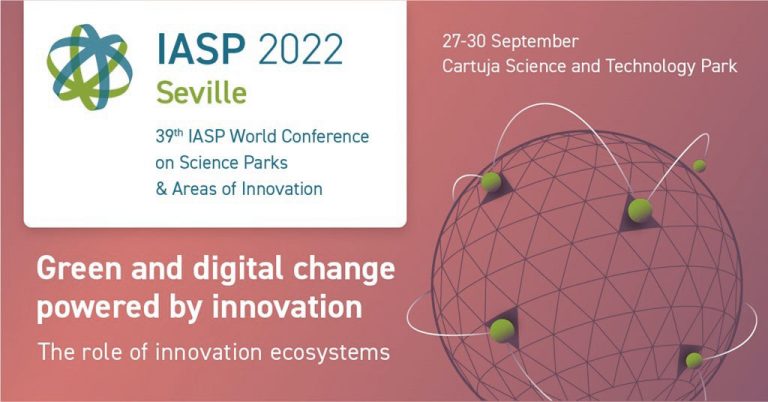IASP 2022
Green and digital change powered by innovation: The role of innovation ecosystems

At the 39th IASP World Conference on Science Parks and Areas of Innovation, our main theme was “Green and digital change powered by innovation: The role of innovation ecosystems”.
Speakers and experts from around the world explored the leading role that innovation ecosystems can play in consolidating global efforts to combat the greatest threats facing the world today, such as climate change.
Science parks and areas of innovation are spaces where new thinking builds solutions to solve current challenges. With climate change, there are an abundance of challenges to meet, and digital technologies play a central role in the energy systems of the future, as well as in the development of data-driven climate solutions, monitoring systems, models for behavioural change and much more, helping us move towards a carbon neutral future.
Strategic orientations that clearly prioritise green and digital solutions are essential on the path to post-pandemic recovery. With the SDGs this is high on the agenda, and in the example of Europe where the European Commission focus on ‘twin transitions’ (green and digital transitions), we can see these two agendas placed side by side to achieve sustainable prosperity in our climate goals.
The innovative companies that thrive in science parks and areas of innovation demonstrate the role new emerging tech can play in mitigating and adapting to climate change, such as increased energy efficiency in consumer products and in industry, climate predictions or material optimization. As spaces that bring together universities, the public and private sectors, venture capital, startups and entrepreneurs, innovative corporates, as well as their local community and wider society, we discussed the unique capacity of innovation ecosystems to accelerate the pace of crucial innovation.
Our 2022 world conference explored the myriad ways in which innovation ecosystems can and do support green and digital change across sectors, and the new methods they will deploy to do so in the future.
Destination: Seville
The Guadalquivir river – the ancient Betis – flows between the foothills of the Sierra Morena to the north and the Sierra Sur mountains in the south, irrigating a rich and fertile valley. In its lower course, 70 kilometres from the sea, is the ancient city of Seville, the capital of the Autonomous Region of Andalusia and of the largest and most densely populated province in Andalusia.
The towns and cities on the shores of the river are living testimony to its historic and cultural past. Seville, the emblematic city of universal renown, has been Arab, Jewish and Roman, and its river and its river port have served as a privileged destination for trade with the West Indies. Its art and folklore make this an exceptional tourist destination.
Local host: Cartuja Science and Technology Park
The Cartuja Science and Technology Park is the first international example of re-use of premises inherited from a universal exhibition (Expo’92) in a space that links up the University, Science and Enterprise.
Its success is reflected in its motto: innovate, collaborate, grow.
The Cartuja STP is a public policy instrument which seeks to enhance local economic development and technological modernisation. It encourages private investment in R&D&I by offering itself as an innovative space, where cooperation is the basis for growth. It integrates scientific, technical and social capacities that facilitate the creation, transmission, dissemination, measurement and management of knowledge and its application in productive activities.
Human capital is the main asset of its companies and research centres.
The Cartuja STP also has an added advantage: Its privileged setting. It is an urban park, just a few minutes’ walk from the historic centre of Seville, and less than 20 minutes from both the airport and the high-speed railway network train station.
What really constitutes the heart of the Cartuja STP are its scientific and technological companies and establishments. In addition to these are the areas dedicated to culture, leisure and sport. Together they constitute a cluster of excellence.
The Park is a true business, scientific and technological engine that is in continuous development. As a result, the cluster houses 536 companies and establishments that generate direct employment for 23,701 workers and an economic activity of 2.987 million euros (data for the financial year 2020) . See Report 2020
